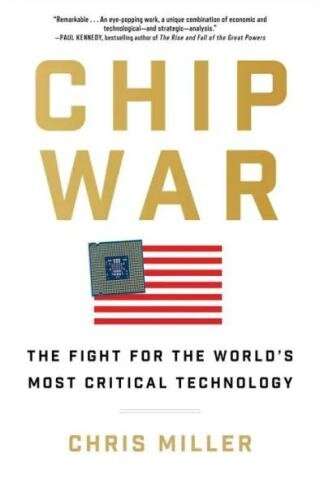
Semiconductors—the digital machinery that runs smartphones and computers, and helps run everything from cars and doorbells to water and power supplies and military systems—are ubiquitous.
Also called chips or integrated circuits, they are usually pieces of silicon with transistors etched in them—transistors keep track of the 1s and 0s that run all digital systems. Back in the late 1950s, getting four transistors to work on a small piece of silicon was a big accomplishment. The latest iPhone14’s processor has 16 billion transistors.
While the United States has led the development of chips, most are now fabricated outside the country. Taiwan and South Korea have cornered the market on building the most advanced chips—though the U.S. and China are trying to change that. Having the world’s leading makers in political hotspots is a concern, too.

In his new book “Chip War: The Fight for the World’s Most Critical Technology,” Chris Miller, an assistant professor of international history at The Fletcher School, tells the story of semiconductors and their crucial role today.
He covers the creation of the technology, the fierce competition in the industry, the astounding scientific advances that propel chips into every aspect of our lives, and why the U.S. and China both view them as critical to national security.
“Policymakers in Washington and Beijing increasingly realize that chips are fundamental to military power, as well as crucial to driving the civilian economy,” says Miller, who is also Jeane Kirkpatrick Visiting Fellow at the American Enterprise Institute this year.
Tufts Now spoke with Miller to learn more about chips, their history, and why they are driving competition between the U.S. and China.
Tufts Now: Gordon Moore of U.S chip powerhouse Intel predicted in 1970 that computing power would double every year or two, which came to pass. How important is that?
Chris Miller: We’ve gotten exponential growth and power over the past 60 years—if you don’t think about it, it doesn’t sound that crazy, but what if the rest of the economy provided a doubling in power every two years?
What if airplanes flew twice as fast every two years? Or houses got twice as big every two years, or cars got half as expensive every two years?
You realize that the rest of economic life doesn’t work that way. But that’s the dynamic that provides a billionfold increase in computing power over 60 years, which is what we’ve gotten. We often take for granted that that’s possible, when in fact it’s one of the most unique economic phenomena of modern times.
You write extensively about the national security consequences of chip manufacturing. How has that changed over time?
One of the constants is that chips are crucially important for military systems. It was that way when chips were first invented in the 1950s to fit into missile guidance computers. Today military systems are even more dependent on computing power, on memory, on signals processing.
The U.S. military is now, like the rest of the world, reliant in many cases on Taiwan and South Korea to produce the chips that defense systems need. That’s created new challenges. The Pentagon has had to get comfortable with sourcing some of the most critical technologies from other countries, which is not something they wanted to have to do. But right now, there’s just no other option.
As the U.S. falls behind in certain chipmaking spheres, the question is whether China is going to advance in a way that gives China an advantage in technology, or at least closes the gap between the U.S. and China in military terms.
The U.S. has always relied on its technological advantage to undergird its military power. If that advantage degrades that will have major ramifications for military power.
The U.S. started out fabricating chips, but soon they were offshored, mostly to East Asia. Why is that?
It’s cheaper generally to produce advanced chips in South Korea and Taiwan, and to some extent in China, because tax incentives in those countries are dramatically more generous and environmental regulations are looser—and there are a lot of toxic chemicals needed in chipmaking. Labor costs are only a small part of the story.
In general, it’s easier to get permits to open a factory in Taiwan. Chips are 42% of exports in Taiwan, so if someone wants to open a chip factory, everyone’s going to make sure it happens. In the U.S., chips are important, but not nearly as important as in other countries, so we focus less on them and permitting is harder.
It’s also true that U.S. firms that used to be leaders have in some cases screwed up in recent years. The best example is Intel, which is the biggest U.S. producer of processor chips, and used to be the world’s most advanced in terms of technology. But it has had some real stumbles in the past half decade or so and is now trying to recover from them. For example, it used to have the technological lead, but has fallen behind Taiwan Semiconductor Manufacturing Company.
How did Taiwan Semiconductor Manufacturing Company—TSMC—end up with 37% market share of logic chips, the ones that go in smartphones and computers?
You have to give their corporate leadership a lot of credit. They’ve managed their company more effectively than any in the world, and they have a really smart business model. They were the first company to focus not on both designing and producing chips in house, but rather to solely produce chips that were designed by other companies. At the time, that was a radical innovation in the business model.
As they grew in volume, they were able to hone their production processes thanks to the large volume that they were producing. The more chips you produce, the more you learn, the more cost-efficient factory production becomes.
They’ve turned into a real juggernaut. Today they produce more logic chips than anyone else by a pretty large margin and they’ve got the most advanced technology. It’s basically impossible to imagine the computing infrastructure we rely on—whether it’s phones or computers or data centers or cell phone towers—without TSMC.
China considers Taiwan a ‘renegade province’ and has threatened to invade it. What would happen to the world’s supply of advanced chips is war broke out there?
The impact would be disastrous. Smartphone production would grind nearly to a halt. The number of PCs produced would fall dramatically. The impact would be measured in the trillions of dollars.
You write that in the 1980s, Japanese companies took over the memory chip business, and it seemed like they were well on their way to being top producers for all chips worldwide. But they stumbled badly in the 1990s and are not major chip producers now. Could the same thing happen to today’s top producers, Taiwan, South Korea, and China?
Japan invested very heavily in memory chips in the late ’70s and throughout the ’80s, and they did very well in it. But they invested beyond the capacity the market needed and ended up with a lot of facilities that were not very profitable. They spent the ’90s trying to bring their chip industry back to profitability, and missed many key trends like personal computers.
The most likely candidate for a Japan-style rise and fall is China, which is pouring money into its chip industry, and doing so in ways that are not economically efficient. There’s a substantial risk that a lot of the money China’s putting into its chip industry will end up being not commercially viable.
The Russian military fighting in Ukraine seems to be at a disadvantage in advanced weaponry. How advanced is Russia in the chip technology field?
Russia has been a player in chip production since the early days of the industry, but it’s always been a small player. It always relied on copying or smuggling foreign technology for its chip industry. That produces problems today because military equipment is more dependent than ever on computing power.
If you take apart the guidance computers of Russian missiles that have been acquired on battlefield in Ukraine, you find that Russian missiles are full of American and South Korean and Taiwanese chips. Because they’re smuggled in, Russia’s often using chips that are not perfectly suited for a given use case.
One of the challenges that Russia faces is that it can’t produce enough and it can’t produce high quality guidance systems for its munitions, which has been one of the many problems that it has faced in Ukraine.
Taiwan chipmaker TSMC says quarterly profit $8.8 billion
Citation:
The history of the semiconductor industry and why it is so critical and politically sensitive (2022, October 14)
retrieved 14 October 2022
from https://techxplore.com/news/2022-10-history-semiconductor-industry-critical-politically.html
This document is subject to copyright. Apart from any fair dealing for the purpose of private study or research, no
part may be reproduced without the written permission. The content is provided for information purposes only.
Stay connected with us on social media platform for instant update click here to join our Twitter, & Facebook
We are now on Telegram. Click here to join our channel (@TechiUpdate) and stay updated with the latest Technology headlines.
For all the latest Technology News Click Here
For the latest news and updates, follow us on Google News.
